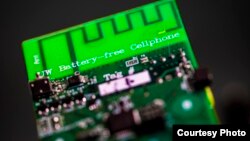Researchers have built a cellphone that does not need batteries. They say the phone can send and receive calls using power from radio signals or light.
A team from the University of Washington in Seattle is currently testing a prototype of the phone.
The researchers were able to develop a device that uses much less power than any cellphones used today. This design allows the new phone to run on very small amounts of electricity.
Team member Vamsi Talla says the phone picks up small electrical signals known as radio frequency, or RF waves.
“Ambient RF waves are all around us. So, as an example, your FM station broadcasts radio waves, your AM stations do that, your TV stations, your cellphone towers. They all are transmitting RF waves.”
The phone can also convert ambient light into electrical current for power, according to the researchers.
Shyam Gollakota is a professor in the Paul G. Allen School of Computer Science and Engineering. He says the invention demonstrates great progress in new cellphone technology.
“This battery-free phone is a major leap in terms of the capabilities of battery-free devices. Because now we have a streaming device that can continuously talk as well as receive data, which is basically a phone.”
The phone identifies speech going into the microphone and coming out of the speaker. These speech vibrations are then converted into radio signals by a device called a base station.
The prototype has been able to operate on power gathered from radio signals from a base station up to nine meters away, according to the researchers. Using power from ambient light, it has communicated with a base station up to 15 meters away.
The team says the base station operating model could eventually be widely used by putting the technology in existing cellphone towers and Wi-Fi systems.
The researchers demonstrated the phone in a test with the calling service Skype. During the test, the device received an incoming call, made an outgoing call and was able to put callers on hold.
The prototype has limited capabilities because it is not a finished product. For example, users now have to use headphones to hear calls and must also press a button to change between talking and listening. And currently, it can only be used for making calls.
However, the team plans to develop new prototypes that could handle texting, photos and internet use. They are also working on a version that could use a small solar cell to provide power.
Vamsi Talla says he thinks the technology might be able to greatly change the capabilities of all phones.This includes solving one of the biggest problems for all users - dead batteries.
“In the future every smartphone will come with a battery-free mode where you can at least make a voice call when your battery's dead.”
The researchers are hoping to complete a finished product within about nine months.
I’m Bryan Lynn.
Bryan Lynn wrote this story for VOA Learning English based on reports from Reuters and the University of Washington. Hai Do was the editor.
We want to hear from you. Would you pay more for a phone that does not need a battery? Write to us in the Comments section, and visit our Facebook page.
_____________________________________________________________
Words in This Story
prototype – n. original or first model of something from which others are developed or made
ambient – adj. existing in the surrounding area
convert – v. change from one thing into another
leap – n. sudden change or improvement in something
microphone – n. device people speak into that records sounds
vibration – n. continuous shaking movement
button – n. small part of a machine or device that is pushed to make it work
solar – adj. of or related to the sun











